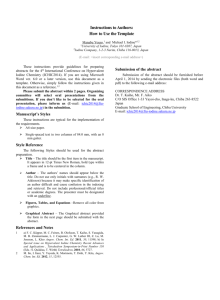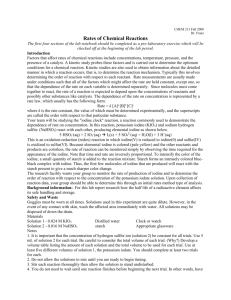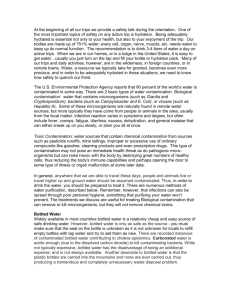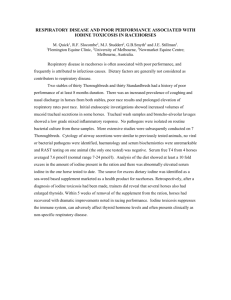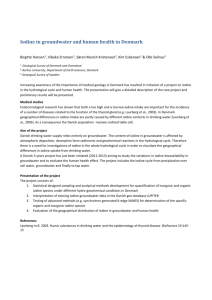Portable water purification
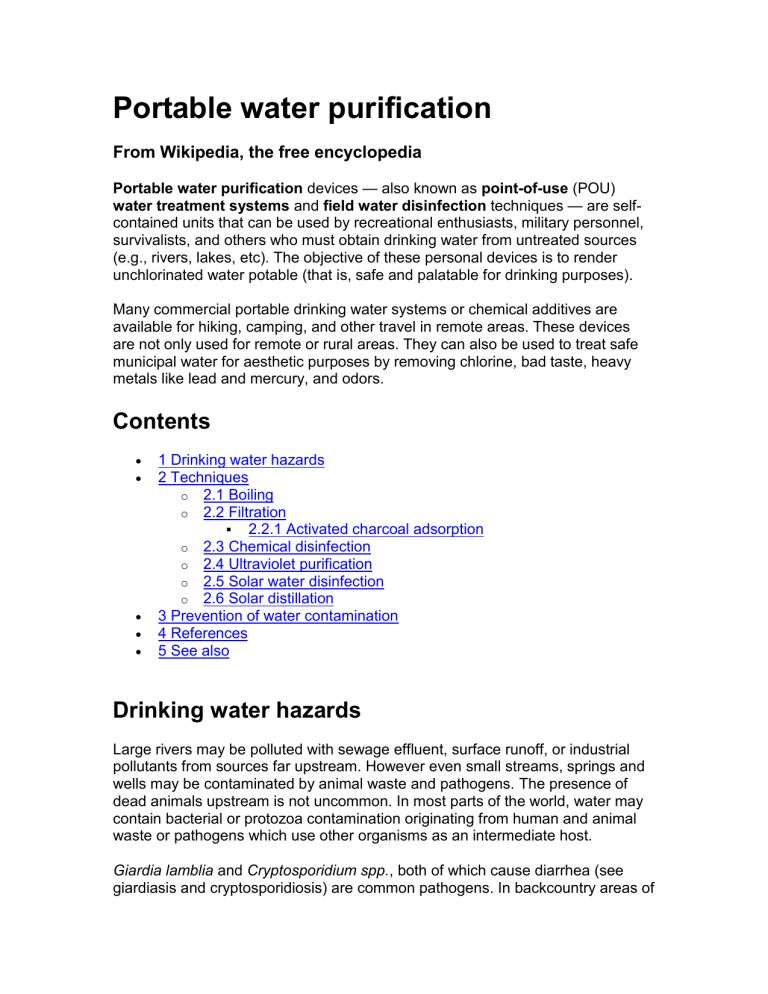
Portable water purification
From Wikipedia, the free encyclopedia
Portable water purification devices — also known as point-of-use (POU) water treatment systems and field water disinfection techniques — are selfcontained units that can be used by recreational enthusiasts, military personnel, survivalists, and others who must obtain drinking water from untreated sources
(e.g., rivers, lakes, etc). The objective of these personal devices is to render unchlorinated water potable (that is, safe and palatable for drinking purposes).
Many commercial portable drinking water systems or chemical additives are available for hiking, camping, and other travel in remote areas. These devices are not only used for remote or rural areas. They can also be used to treat safe municipal water for aesthetic purposes by removing chlorine, bad taste, heavy metals like lead and mercury, and odors.
Contents
o
o o
2.2.1 Activated charcoal adsorption
o o
o
3 Prevention of water contamination
5 See also
Drinking water hazards
Large rivers may be polluted with sewage effluent, surface runoff, or industrial pollutants from sources far upstream. However even small streams, springs and wells may be contaminated by animal waste and pathogens. The presence of dead animals upstream is not uncommon. In most parts of the world, water may contain bacterial or protozoa contamination originating from human and animal waste or pathogens which use other organisms as an intermediate host.
Giardia lamblia and Cryptosporidium spp.
, both of which cause diarrhea (see giardiasis and cryptosporidiosis) are common pathogens. In backcountry areas of
the United States and Canada they are sometimes present in sufficient quantity that water treatment is justified for backpackers, [1] although this has created some controversy.
[2][3] (See Wilderness acquired diarrhea.) In Hawaii and other tropical areas, Leptospira spp.
are another possible problem.
[4] (See
Leptospirosis.)
Less commonly seen in developed countries are organisms such as Vibrio cholerae which causes cholera and various strains of Salmonella which cause typhoid and para-typhoid diseases. Pathogenic viruses may also be found in water. The larvae of flukes are particularly dangerous in area frequented by sheep, deer, or cattle. If such microscopic larvae are ingested, they can form potentially life threatening cysts in the brain or liver. This risk extends to plants grown in or near water including the commonly eaten watercress.
Techniques
Boiling
Boiling is the best method to make water containing pathogens safe to drink in the absence of pollutants (i.e., chemicals, heavy metals, etc.). Boiling water will kill bacteria as well as other disease-causing microorganisms like Giardia lamblia and Cryptosporidium parvum which are commonly found in rivers and lakes. At high elevations, though, the boiling point of water drops, so that extra boiling time is require d. Water temperatures above 70 °C will kill all pathogens within 30 minutes, above 85 °C within a few minutes, and at boiling point (100 °C), most pathogens will be killed, excluding certain pathogens and their spores, which must be heated to 118 degrees Celsius (e.g.: botulism - Clostridium botulinum ).
This can be achieved by using a pressure cooker, as regular boiling will not heat water past 100 degrees Celsius. It is worth noting that not all pollutants are removed from water by boiling, however, even in a pressure cooker. Boiling cannot remove chemicals having boiling points at or above 100 °C, nor heavy metal contamination, e.g., colloidal metal pollutants. Activated charcoal, however, can remove many pollutants, without removing pathogens. A combination of boiling at atmospheric pressure (i.e., not in a pressure cooker) plus filtering with activated charcoal can neutralize most pathogens and pollutants.
Filtration
Scanning electron microscope of a number of Leptospira sp. bacteria atop a 0.1
µm polycarbonate filter
Portable pump filters are commercially available with ceramic filters that filter
5,000 to 50,000 litres per cartridge, removing pathogens down to the 0.2
–0.3 micrometer (µm) range. Some also utilize activated charcoal filtering. Most filters of this kind remove most bacteria and protozoa, such as Cryptosporidium and
Giardia lamblia, but not viruses except for the very largest of 0.3 micrometer and larger diameters, so disinfection by chemicals or ultraviolet light is still required after filtration. It is worth noting that not all bacteria are removed by 0.2 micron
(micrometer) pump filters; for example, strands of thread-like Leptospira spp.
bacteria, (that can cause leptospirosis), are thin enough to pass through a 0.2 micrometer filter. Effective chemical additives to address shortcomings in pump filters include chlorine, chlorine dioxide, iodine, and sodium hypochlorite (bleach).
There have been polymer and ceramic filters on the market that incorporated iodine post-treatment in their filter elements to kill viruses and the smaller bacteria that cannot be filtered out, but most have disappeared due to the unpleasant taste imparted to the water, as well as possible adverse health effects when iodine is ingested over protracted periods.
While the filtration elements may do an excellent job of removing most bacteria and fungi contaminants from drinking water when new, the elements themselves can become colonization sites. In recent years some filters have been enhanced by bonding silver metal nanoparticles to the ceramic element and/or to the activated charcoal to suppress growth of pathogens.
Small, hand-pumped reverse osmosis filters were originally developed for the military in the late 1980s for use as survival equipment, for example, to be included with inflatable rafts on aircraft. Civilian versions are available. Instead of using the static pressure of a water supply line to force the water through the filter, pressure is provided by a hand-operated pump, similar in function and appearance to a mechanic's grease gun. These devices can generate drinkable water from seawater.
Activated charcoal adsorption
Granular activated carbon filtering utilizes a form of activated carbon with a high surface area, and adsorbs many compounds including many toxic compounds.
Water passing through activated carbon is commonly used in concert with hand pumped filters to address organic contamination, taste, or objectionable odors.
Activated carbon filters are used not as primary portable water purification techniques, per se , but, rather, simply to purify water additionally with another portable water purification technique. It is most commonly implemented either through activated charcoal pre-filtering or post-filtering, filtered in a separate step than ceramic filtering, in either case being implemented prior to the addition of chemical disinfectants used to control bacteria or viruses that filters cannot remove. Activated charcoal can remove chlorine from treated water, removing any residual protection remaining in the water protecting against pathogens, and should not, in general, be used without careful thought after chemical disinfection treatments in portable water purification processing.
Chemical disinfection
Turbid creek water caused by heavy rains.
Iodine used for water purification is commonly added to water as a solution, in crystallized form, or in tablets containing tetraglycine hydroperiodide that release
8 mg of iodine per tablet.
[5] The iodine kills many — but not all — of the most common pathogens present in natural fresh water sources. Carrying iodine for water purification is an imperfect but lightweight solution for those in need of field purification of drinking water. Kits are available in camping stores that include an iodine pill and a second pill (vitamin C or ascorbic acid) that will remove the iodine taste from the water after it has been disinfected, such as marketed under the Potable Aqua Plus name. The addition of vitamin C, in the form of a pill or in flavored drink powders, precipitates much of the iodine out of solution, thus it should not be added until the iodine has had sufficient time to work. This time is
30 minutes in relatively clear, warm water, but is considerably longer if the water
is turbid or cold. Consumption of iodine treated drinking water, treated with tablets containing tetraglycine hydroperiodide, also reduces the uptake of radioactive iodine in human subjects to only 2% of the value it would otherwise be, which could be an important factor worthy of consideration for treating water in a post nuclear event survival situation.
[5] Such iodine treated water is not suitable for the small percentage of the population allergic to iodine, a problem that also exists in using iodine based dyes for medical test radiography imaging.
A potentially lower cost alternative to using iodine based water purification tablets is the use of iodine crystals, commonly sold under the Polar Pure name. A small amount of water is poured into a small glass bottle containing the iodine crystals, one waits 30 minutes, and then pours off only the amount of liquid solution needed into a larger source of untreated water such as a canteen. After waiting a small amount of time, lengthened if treating cold water instead of warm water, potable water is then available from the treated water. An advantage of using iodine crystals is that only a small amount of iodine is dissolved from the iodine crystals at each use, giving this method of treating water a capability for treating very large amounts of water, typically over 2,000 gallons, with but a small bottle of crystals. Ingestion of the actual iodine crystals must be avoided when using this method. Unlike the use of tetraglycine hydroperiodide tablets, which have a shelf life of only 3 months once their container bottle is opened, iodine crystals have essentially an unlimited shelf life as long as they are not exposed to air for long periods of time and are kept under water. (Iodine crystals will sublimate if exposed to air for long periods of time.) The large quantity of water that can be purified with iodine crystals at low cost makes this technique especially cost effective for point of use or emergency water purification methods intended for use longer than 3 months. Care must be taken to prevent the small glass bottle of iodine crystals covered with water from freezing in cold climates.
Chlorine-based halazone tablets were formerly popularly used for portable water purification. Chlorine in water is more than three times more effective as a disinfectant against Escherichia coli than an equivalent concentration of iodine.
[6]
Halazone tablets were thus commonly used during World War II by U.S. soldiers for portable water purification, even being included in accessory packs for Crations until 1945. The primary limitation of halazone tablets was the very short usable life of opened bottles of halazone tablets, typically 3 days or less, unlike iodine based tablets which have a usable open bottle life of 3 months. Sodium dichloroisocyanurate has largely displaced halazone tablets for the few remaining chlorine based water purification tablets available today. Still, despite chlorinebased portable water purification falling from favor in tablet form such as in halazone tablets, chlorine-based bleach may nonetheless safely be used for short term emergency water disinfection. Add 2 drops of unscented 5% bleach per litre or quart of clear water, then let stand covered for 30 to 60 minutes. After this it may be left open to reduce the chlorine smell and taste. Guidelines are available online for effective emergency use of bleach to render unsafe water potable.
[1][2] USAID is promoting a similar product (a sodium hypochlorite
solution) which is sold in developing countries specifically for the purpose of disinfecting drinking water.
Neither chlorine (e.g., bleach) nor iodine alone is considered completely effective against Cryptosporidium , although they are partially effective against Giardia .
Iodine should be allowed at least 30 minutes to kill Giardia. Chlorine is considered slightly better than iodine against Giardia . A more complete field solution that includes chemical disinfectants is to first filter the water, using a 0.2 micron ceramic cartridge pumped filter, followed by treatment with iodine or chlorine, thereby filtering out cryptosporidium, Giardia, and most bacteria, along with the larger viruses, while also using chemical disinfectant to address smaller viruses and bacteria that the filter cannot remove. This combination is also potentially more effective in some cases than even using portable electronic disinfection based on UV treatment, using such as using a Steripen, that fails to work for other than very clear water.
An alternative to iodine based preparations in some usage scenarios are silver ion/chlorine dioxide based tablets or droplets. Sold under names like Micropur
Forte, Aquamira, and Pristine, these solutions may disinfect water more effectively than iodine based techniques while leaving hardly any noticeable taste in the water in some usage scenarios. Silver ion/chlorine dioxide based disinfecting agents will kill Cryptosporidum and Giardia , if utilized correctly. The primary disadvantages of silver ion/chlorine dioxide based techniques are the long purification times (generally 30 minutes to 4 hours, depending on the formulation used) and the fact that these chemical disinfection agents cannot provide any protection against the uptake of radioactive iodine into one's thyroid in a post-nuclear survival scenario, which could potentially be a concern.
Additional concerns involve the possible deposition and accumulation of silver compounds in various body tissues leading to a rare condition called argyria that results in a permanent, disfiguring, bluish-gray pigmentation of the skin, eyes, and mucous membranes.
Ultraviolet purification
Ultraviolet (UV) light induces the formation of covalent linkages on DNA and thereby prevents microbes from reproducing. Without reproduction, the microbes become far less dangerous. Germicidal UV-C light in the short wavelength range of 100 –280 nm acts on thymine, one of the four base nucleotides in DNA. When a germicidal UV photon is absorbed by a thymine molecule that is adjacent to another thymine within the DNA strand, a covalent bond or dimer between the molecules is created. This thymine dimer prevents enzymes from "reading" the
DNA and copying it, thus neutering the microbe. Hydro-Photon introduced the portable UV water purifer, with the brand name SteriPEN. These UV water purifiers are lightweight and work very quickly. Still, there are limits to this technology. Water turbidity (i.e., the amount of disolved solids contained in the water to be treated) must be low, such that the water is clear, for UV purification
to work well. Also, water treated with UV still has the microbes present in the water, only with their means for reproduction turned "off". In the event that such
UV treated water containing neutered microbes is exposed to visible light
(specifically, wavelengths of light over 330-500 nm) for any significant period of time, a process known as photoreactivation can take place, whereby there becomes a possibility for repairing the damage in the bacteria's reproduction
DNA, potentially rendering them once more capable of reproducing and causing disease.
[7] UV treated water must therefore not be exposed to visible light for any significant period of time after UV treatment, before consumption, to avoid ingesting reactivated and dangerous microbes. For long term usage, the issue of obtaining batteries to power portable water purification UV devices can be a concern. Another concern with UV portable water purification is that some pathogens are hundreds of times less sensitive to UV light than others, with protozoan cysts being among the least sensitive. As a result, Giardia are not destroyed or deactivated by most UV treatment units, being especially resistant to UV. Fortunately, Giardia are among the easiest pathogens to filter out of water. A viable two-step portable water purification approach, providing greater protection than UV purification alone, is to first filter suspect water, thereby removing the large UV-resistant pathogens, prior to using UV purification.
Solar water disinfection
Main article: SODIS
In solar water disinfection (SODIS), microbes are destroyed by temperature and
UVA radiation provided by the sun. Water is placed in a transparent plastic PET bottles, which is first oxygenated by shaking partially-filled capped bottles prior to filling the bottles all the way. The completely water-filled and capped bottles are exposed to sunlight, preferably on a corrugated metal roof, slanted slightly to maximize the exposure to solar radiation. In practice, the water-filled bottles are placed for six hours in full sun, or for two days in partial sunlight for weather conditions involving partially overcast days, which raises the temperature of the water and gives an extended dose of solar radiation to the water in the bottles, killing almost all microbes that may be present. The combination of the two effects (UVA and heat) provides a simple method of disinfection for use in tropical developing countries, or in survival situations. The use of glass bottles may or may not provide the same degree of SODIS disinfection as using PET bottles. This is because most glass bottles are non-transparent or opaque over the wavelengths of sunlight required for successful UV disinfection from the solar spectrum required for SODIS to work, and glass bottles are usually thicker than
PET bottles, which further reduces the dose of UVA to the water inside glass bottles versus PET bottles. For cases where the UVA is blocked, or reduced, only the heating effects without adequate UVA exposure are typically at work if glass bottles are used, potentially leaving dangerous amounts of bacterial and viral loads within the water.
Solar distillation
Main article: Solar still
Solar distillation may use a pre-manufactured and easily portable still, commonly referred to as a solar still, but it has its roots in a makeshift still that can be constructed simply from readily available components, typically being placed over a small pit that is dug into the ground. The solar still relies on sunlight to warm and evaporate the water to be purified. The water vapor condenses, usually on a plastic sheet suspended as an inverted cone, dripping into a collection cup placed beneath its center. For more continuous use, thin tubing or a hose is sometimes routed into the collection cup beneath the inverted cone, permitting repeated removal of water without disturbing the inverted cone upon which water condenses. This is potentially an important method to prevent losing moisture to atmospheric air, such as can occur in the desert, if the inverted cone is removed each time distilled water is removed from the cup. An alternative method based on the same technique is to tie a plastic bag over a branch of vegetation, to capture water released by the vegetation during photosynthesis.
Note that while the solar still shares exposure to UV and infra-red radiation with
SODIS, along with the use of plastic materials (sheeting in place of a PET bottle), a solar still relies on a completely different mechanism for operation and the two methods should not be confused. In an extreme survival situation, a solar still can be used to prepare safe drinking water from usually unsuitable water sources, such as one's own urine, or even sea water.
Prevention of water contamination
Only in very high-use wilderness areas is it recommended that all waste be packed up and carted out to a properly designated disposal point. The vast majority of the time it is perfectly safe to bury human waste, 100 yards or more from all marked trails and 200 yards or more from running water or campsites.
References
1. ^ Boulware DR, Forgey WW, Martin WJ 2nd (2003), " Medical Risks of
Wilderness Hiking ", Am J Med 114 (4): 288 –93. PMID 12681456 .
2. ^ http://www.ncbi.nlm.nih.gov/pubmed/10737847?dopt=Citation
3. ^ Sierra Club, Giardia.
4. ^ What is Leptospirosis?
(State of Hawaii government brochure.)
5. ^ a b LeMar HJ, Georgitis WJ, McDermott MT (January 1995). "Thyroid adaptation to chronic tetraglycine hydroperiodide water purification tablet use". The Journal of Clinical Endocrinology and Metabolism 80 (1): 220 –3.
PMID 7829615 .
6. ^ Koski TA, Stuart LS, Ortenzio LF (01 Mar 1966). " Comparison of chlorine, bromine, iodine as disinfectants for swimming pool water.
".
Applied Microbiology 14 (2): 276 –279. PMID 4959984 . PMID 4959984 . http://www.pubmedcentral.nih.gov/articlerender.fcgi?tool=pubmed&pubme did=4959984 .
7. ^ Survival of Shewanella oneidensis MR-1 after UV Radiation Exposure ,
Photoreactivation of MR-1, a microbe 44% similar to E-coli .

